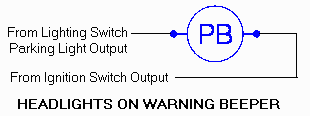The MGA With An Attitude
Headlights On WARNING BUZZER - ET-245
By popular demand, here is the simple installation for a buzzer that will sound if you switch off the ignition and leave the lights on. First I present The Vintage Method.
You need any12-volt DC noise maker of your choice. It may be hard to find the old electromechanical buzzers any more (work like the car horn only smaller).
 www.radioshack.com/product/index.jsp?productId=2102817
www.radioshack.com/product/index.jsp?productId=2102817
300-500Hz buzz tone, 75dB, 12vDC, 15mA max
If you're cheap you could even hook it to the car horn instead.
 For an electromechanical buzzer you need a tiny bit of logic to tie together parking light output and ignition switch output. The simple form of this would be a miniature or micro single-pole normally-closed relay (or single-pole double-throw).
For an electromechanical buzzer you need a tiny bit of logic to tie together parking light output and ignition switch output. The simple form of this would be a miniature or micro single-pole normally-closed relay (or single-pole double-throw).
www.radioshack.com/product/index.jsp?productId=2062479
www.radioshack.com/product/index.jsp?productId=2062481
A crafty electronics guru might be able to do it with a transistor or two instead of the relay.

Connect parking light terminal of lighting switch to buzzer, connect buzzer to relay Com or NC terminal, and the relay NC or Com terminal to ground. That will make it buzz with lights on. Connect ignition switch output to relay coil, then other side of relay coil to ground. That will switch the relay to break ground and kill the buzzer when ignition is on. These things are so small you can epoxy them to back of the dash panel.
And now for The Modern Method.

A piezoelectric buzzer also works fine for this function.
www.radioshack.com/product/index.jsp?productId=2062397
2800Hz, 76dB, 6-18vDC, 10mA@12v
www.radioshack.com/product/index.jsp?productId=2062402
1500-3000Hz,
The piezo buzzer works like a diode, only passing current in one direction. These will then be polarized, so you have to connect the positive wire to battery positive. Nice thing about this is that you do not need a relay for this application.

Connect the piezo buzzer between the ignition switch output and the lighting switch parking light output. Switch on parking lights. If it doesn't buzz, swap the wires on the piezo buzzer.
With ignition and lights on at the same time the buzzer has 12 volts on both sides, will pass no current, and will not sound. With ignition switch on but no lights, the piezo buzzer has 12 volts on one side but will not pass current in that direction, so also does not sound. With lights on and ignition switch off, the piezo buzzer gets power from the lighting circuit and finds ground return through the ignition coil (when ignition contact points are closed) or through the fuel pump or fuel gauge. The piezo buzzer has such high internal resistance (only a 10mA device) that the lower resistance circuits conduct current like ground connection for the buzzer. Current is limited to 10mA by the buzzer, so nothing happens in the ignition or fuel pump or fuel gauge (or heater fan, wipers or radio if any of those were left on). The little piezo buzzer could buzz loudly for six weeks before it would bleed 10 Amp-Hr of power out of the car battery.
And the Easier Method with a Buzzer:
 When you understand that a diode will pass current only in one direction, you can connect a mechanical buzzer with a diode to eliminate the relay. In this case the diode must have enough current capacity to handle the current draw of the buzzer. Connect buzzer and diode in series between ignition switch output and lighting switch parking light terminal. If it doesn't buzz with lights on and ignition off, reverse the diode. This also assumes that the buzzer has high enough resistance and low enough current draw that it can be grounded through the ignition coil and/or fuel pump coil.
When you understand that a diode will pass current only in one direction, you can connect a mechanical buzzer with a diode to eliminate the relay. In this case the diode must have enough current capacity to handle the current draw of the buzzer. Connect buzzer and diode in series between ignition switch output and lighting switch parking light terminal. If it doesn't buzz with lights on and ignition off, reverse the diode. This also assumes that the buzzer has high enough resistance and low enough current draw that it can be grounded through the ignition coil and/or fuel pump coil.
|